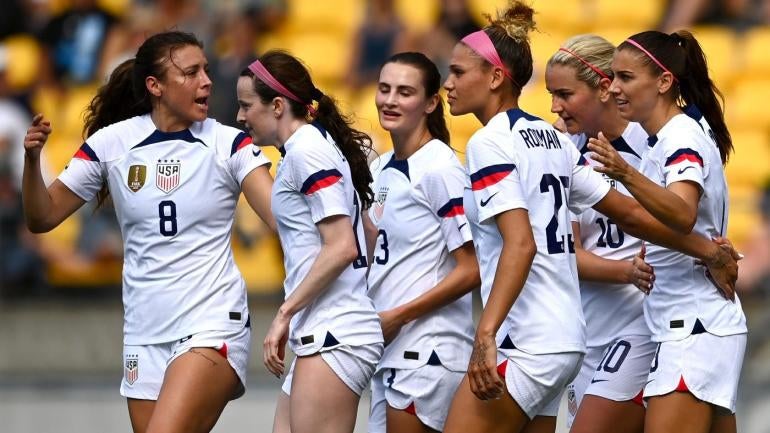
The United States women's national team completed their January camps with a two-game sweep of New Zealand this month. Head coach Vlatko Andonovski named a 24-player roster to kick off the new year and reintroduced some previously injured or absent players back into the mix. The team gathered for a six-day training camp and closed out their time in the 2023 FIFA Women's World Cup co-host nation, but they exit New Zealand with more than just a pair of victories.
Let's take a look at some takeaways from the overall January camp, which saw the U.S. win their games 4-0 and 5-0.
It was always about the experience
Opening up the year against the World Cup co-hosts offered a unique opportunity for players among the current pool to get some valuable experience. In an environment that will mirror their World Cup group stage, the team trained, traveled, and played in Wellington and Auckland. For many players on the team, their first camp call-ups were made during Andonovski's time as head coach since replacing Jill Ellis in 2019. Only 10 players on the roster have represented the team in either a World Cup or Olympics and the remaining 14 are still on the journey to make appearances at peak international tournaments.
The USWNT historically have had a winning record against New Zealand and lopsided scorelines to go with the victories. The two-game series against New Zealand provided minimal challenges to the team overall, the main rival being offseason rust and lack of form in the first half of the opening match. The group adjusted, through talent and ability, to record nine goals over two matches. The bigger lesson came in the play from those on the hunt for their first-ever World Cup appearance.
The 2023 World Cup is officially six months away, and FIFA's recent rejection of 26 player roster proposal could mean the return of 23-player rosters for the World Cup. Out of New Zealand, it was reported by The Athletic that the technical staff has narrowed down the player pool to 32, down from 40, ahead of the tournament. The return to pre-covid rosters will only make a final roster harder to crack.
Want more coverage of women's soccer? Listen below and make sure to follow Attacking Third, A CBS Soccer Podcast devoted to bringing you everything you need to know from the NWSL and around the globe.
Cause for concern
A system built for a No. 6 in the defensive mid role has been a double-edged sword for the team. An incredible unit when the central mid can link the backline and the frontline through their disruptive ball-winning and distribution, it allows freedom for the No. 8 to generate attacking play when necessary. The coaching staff still appears to look for a solution in Julie Ertz's absence as she navigated a knee injury post-Tokyo Olympics and is now on maternity leave following the birth of her son in August.
To further complicate matters, the coaching staff has shifted their responses to the media on the future availability of Samantha Mewis -- who was a staple alongside Ertz. The central mid has been navigating a long-term knee injury with no current timetable to return. Mewis was previously mentioned among the long list of players out with injury who could return, but Andonovski has stated the staff will no longer go into details on Mewis' status.
Vlatko on Sam Mewis: It’s a long term injury, does not want to go in to details, and said they don’t want to comment on timeline or her possible return at all.
— Meg Linehan (@itsmeglinehan) January 17, 2023
Avoided the question of World Cup for Mewis pretty entirely. #USWNT
Standout performances
Continued tinkering by the coaching staff with different looks in the midfield was again the theme over the pair of friendlies in New Zealand. Taylor Kornieck was utilized as a defensive mid and featured in minutes in the role in both matches. Despite the constant rotation of the role, including Lindsey Horan, Washington Spirit midfielder Andi Sullivan remains the main option for the position as the team continues its march toward the World Cup.
The January camp was outside an official FIFA window, and it was a unique opportunity that presented itself in New Zealand after Horan returned to her club team in France due to a prior arrangement with Lyon. Building off a successful second-half appearance from the first game, Ashley Sanchez earned a start alongside Rose Lavelle and Sullivan. Lavelle frequently dropped lower throughout the game to allow Sanchez more freedom to generate play higher.
The result was a rare look at Lavelle as a No. 8 for the team as she exited the second game against New Zealand with two goals and an assist. Her success in the role could be another layer for the USWNT and their preparations in the lead-up to the World Cup. With Trinity Rodman and Sanchez possibly seeing more advanced roles after January camps, a peculiar position for Lavelle may be one with a big payoff down the line.
What's next
The team will have a new challenge next month with the SheBelives Cup tournament. The USWNT will host Brazil, Canada, and Japan beginning February 16. The roster could see the return of even more previously injured players, while they still look for answers in the midfield.





















